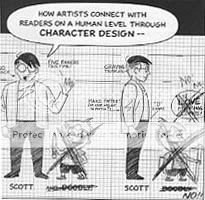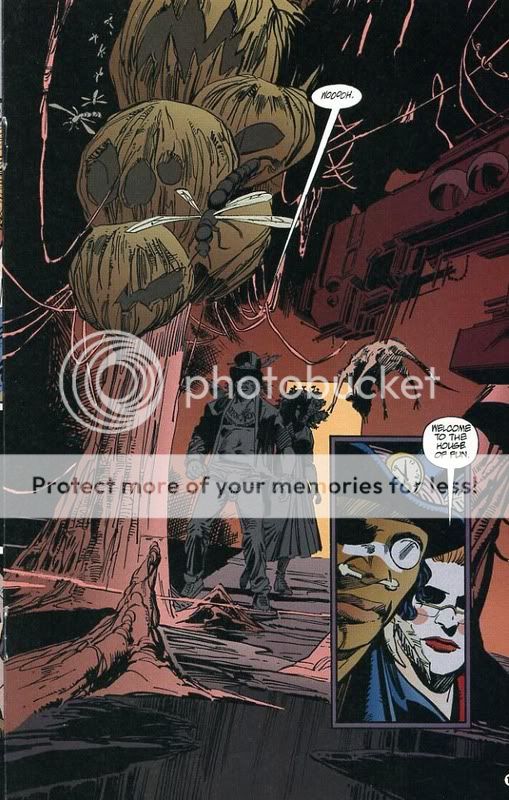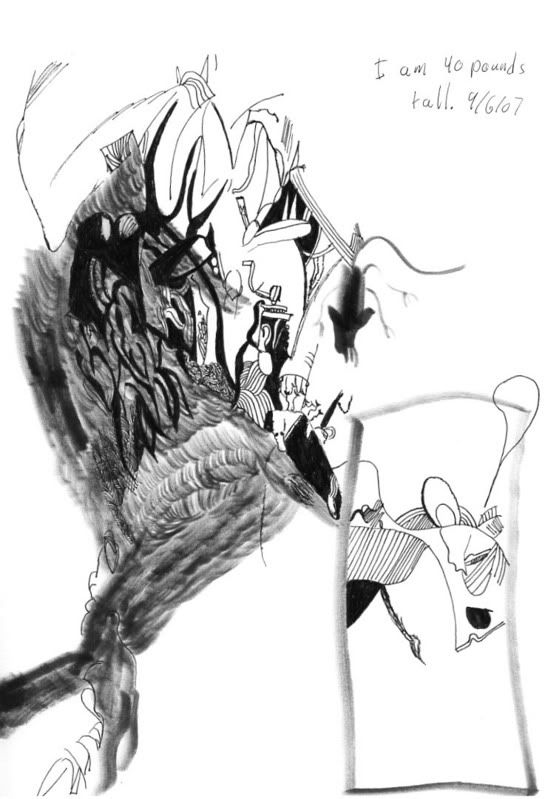This review of Scott McCloud’s “Making Comics” ran in The Comics Journal #280. I’ve added a couple of illustrations, both from the book in question, and both copyright by Scott McCloud.
Making Textbooks
Scott McCloud is comicdom’s leading aesthetician. He’s also responsible for some of the most butt-ugly graphic novels in the business. As my friend art-teacher Bert Stabler put it, reading McCloud’s first book, *Understanding Comics* is “like getting a lecture on sexual titillation from a talking pair of pants filled with lunchmeat.”
The problem here is not that McCloud is a mediocre draftsman: you can criticize an art form without being possessed of a virtuoso technique (or so I like to tell myself). But while you don’t need skill to talk about a medium, you do need a feeling for the form. This McCloud simply does not have. To pick the most obvious example, his cartoon-self is a nadir in the art of self-portraiture. Not realistic enough to be impressive, not hyper-deformed enough to be cute, the Scott icon appears in panel after panel, like some sinister avatar of aggressive mediocrity. After a page or two, I was longing to tear off his pupil-less glasses and shove them down his perpetually gaping mouth.
McCloud’s most recent volume pushes the disjunction between theory and practice to the breaking point. *Making Comics* is a how-to book by a man who can’t. The effect is grotesque — as if the talking pair of pants filled with lunchmeat stopped lecturing and began elaborately miming intercourse with the podium. In his introduction, McCloud actually posits his hideous cartoon-self — now fatter, grayer, computer-aided, and even, impossibly, less appealing — as an example of excellence in character design. In another sequence, he tries to demonstrate how to guide the reader’s eye to the important details in each frame. You’re supposed to follow a magic wand as it taps a hat. But the drawings are so generic and presented with so little panache that my eye refused to take them in; they might as well not have been there. I wouldn’t have known I was supposed to be watching anything at all if the text hadn’t laboriously told me to do so afterwards.

If McCloud’s limitations as a creator merely made it difficult for him to provide good examples, it would be bad enough. But they are so far-reaching that they actually interfere with his ability to understand the material he is putatively teaching. Take the issue of design. McCloud has about as bad an instinct for layout as it is possible for one man to have. Every single page in his book is a cluttered, boring nonentity. As a random example: page 149, like most in the book, is a modified grid. The eye here is drawn to a large, unbordered panel at the middle right, featuring a distinctively ugly graphic of the Mona Lisa’s head trapped in an arrow. The next most prominent panel is in the lower left, showing cartoon-Scott surrounded by a semi-circle of icons demonstrating the possible connections between words and pictures . The overall effect is of a half-assed PowerPoint presentation.

McCloud’s obliviousness to layout has actually been behind some of his most interesting ideas — I don’t think it’s a coincidence that the “infinite canvas” was invented by a man without any appreciation for more finite ones. But however well his blind spot has served him in the past, it’s a huge detriment here. If you’re going to talk about making comics, you really need to discuss how to make pages — and McCloud simply won’t. The closest he comes is a consideration of “flow”: the techniques you use to make sure the reader looks at your panels in the right order. Useful enough, but no substitute for an in-depth discussion of what is arguably comics most important aesthetic unit. Nor can McCloud say he ignored the subject because of lack of room — not when he spends twenty pages telling you how to draw different facial expressions, complete with a diagram illustrating the muscles that control smiling, frowning, raising the eyelids, and so forth. I almost felt sorry for him when, at the end of the explanation, he lamely admits that, for most creators, the bulk of this information is completely useless.
As this indicates, McCloud often seems unsure exactly what it is he’s supposed to be doing. For example, at the beginning of the book he claims his overall purpose is to teach you “storytelling secrets”. But then later he insists — correctly, in my view — that many comics artists are more concerned with visual beauty or formal experiments than they are with storytelling. Or, again at the start, he claims that his ideas are things that “every comics artist needs to tackle before they even pick up a pen.” Then, later, he admits that you don’t really *need* to know a lot of this information, though it might come in handy at some point.
One thing that McCloud *is* clear about is that he is not writing one of those how-to draw books which teach you, step-by-step, to be a shoujo artist or a Jack Kirby clone. But though these books may be limited, they are for that very reason actually able to do what they claim — that is, show you how to draw in a particular style. McCloud, on the other hand, has such diffuse goals that he has trouble explaining them, much less following through. It’s no accident that the best part of his book is a nuts-and-bolts discussion of the pens, papers, and computer tools used by professional artists — a discussion which would fit perfectly into the “how-to” books he slights.
McCloud is right, though — he isn’t writing a how-to book. He’s writing an academic textbook. As it happens, I write textbooks for a living myself, and I must say that, in my experience, it’s a genre badly suited to teach anyone anything. Textbooks are, however, especially ill-equipped to teach art. A textbook relies on lists (“these panel-to-panel transitions come in six varieties”), on sweeping statements (“almost any story can be evaluated on its ability to provoke emotion in the reader”), and on staged, lifeless examples (just read a few pages of “Making Comics” — you’ll find one.) But lists and abstracted examples have very little to do with the visceral ways in which people interact with and/or learn about art. Or, to put it another way, there isn’t any “secret” to being an artist, no complicated formula to learn. Instead, there’s a simple, two step process. (1) Look at a ton of art. (2) Practice copying a ton of art. That’s what all those “how-to” books encourage you to do. It’s how manga artists train in Japan. It’s how I learned about being a writer. And I’d even bet it’s how Scott McCloud picked up the skills he needed to create his charming comic *Zot!* twenty years ago.
If you must write a textbook about art, the least you can do is to include lots of examples from great artists. Yes, of course, if you want to learn how to make comics, you should look at art by Hergé, not a textbook by Scott McCloud which references Hergé. But at least if McCloud included a page of Hergé art in his textbook, there’s a possibility that the reader will get *something* out of it — it’s a chance, in other words, for him to mix some actual medicine with his snake oil.
McCloud does include a lot of art by great creators — Tezuka, Schulz, Ware, and so on. But in almost every case, the images are chopped into bits, tucked into corners, and generally eviscerated. For me, this is where McCloud’s aesthetic clumsiness — in a word, his philistinism — is at its most painful. McCloud claims to love these artists, but he is unable or unwilling to give them space. If you’re going to talk about a Peanuts strip, why not just print it in its entirety? And why not put artists’ credits right next to the panels you’ve chopped from their work, so that a casual reader knows, exactly and instantly, what he or she is looking at, and can start making a mental list of writers and illustrators to check out? The answer could well be simple incompetence; the effect, though is presumptuous, not to mention deadening. “Making Comics” doesn’t present great artists as masters to admire, or emulate, or dismiss, or inspire, or vie with. Rather, it uses them as examples, illustrating particular aspects of one of McCloud’s many esoteric arguments. Talented visionaries are turned into boring footnotes — and this is supposed to inspire the next generation of creators?
McCloud’s attitude toward copying is also wrong-headed. He does mention drawing from life and from photo-reference. But when it comes to imitating the work of other artists, he has little to say, and his few comments are generally negative. For example with those nefarious “how-to” books forever on his mind, he warns against copying facial expressions from other artists since “there are countless ways to draw any expression, and countless artists whose techniques you can study.” True enough — but surely it’s worth pointing out as well that the best way to “study” a technique is not to describe it or think about it, but to copy the damn thing. Like it or not — and McCloud does not seem to — art is a lot closer to being a craft than it is to being an academic discipline. You can burble on all you like about the five kinds of clarity, or Jungian archetypes, or the great potential of the comics form. But at bottom it’s all smoke and mirrors, a worthless and tedious distraction from the hours of imitative practice which are the only real way to master an art form.
When listing the four kinds of comics creators, McCloud likes to posit himself as a formalist — someone interested in understanding and expanding the potential of the comics form. But on the evidence of this book, he isn’t really, deep down, a creator at all. Instead, he’s an educator —here defined loosely as someone who takes in wisdom, knowledge, and beauty, and excretes an odorless gray paste. As a result, and despite the title, “Making Comics” isn’t designed to teach you how to make comics. It’s designed to bore undergraduates. And in that, at least, I am certain it will succeed for many years to come.
*******************************************
When it first ran, this article provoked a heated conversation on the TCJ message board.
In the course of that discussion, cartoonist Jesse Hamm suggested that my own art was relevant to a discussion of this article. I think he’s right, at least to some extent. My own experience learning to draw (which mostly involved copying) had an effect on my reaction to McCloud’s book. In any case, if you want to see my own art (whether to admire or sneer) you can do so here and here. And, finally, here’s me copying a page from Grant Morrison’s Invisibles
Alternately, if you’re in Switzerland in October, some of my drawings will be shown in the huge Lovecraft exhibit at the Maison d’Alleurs this October.




